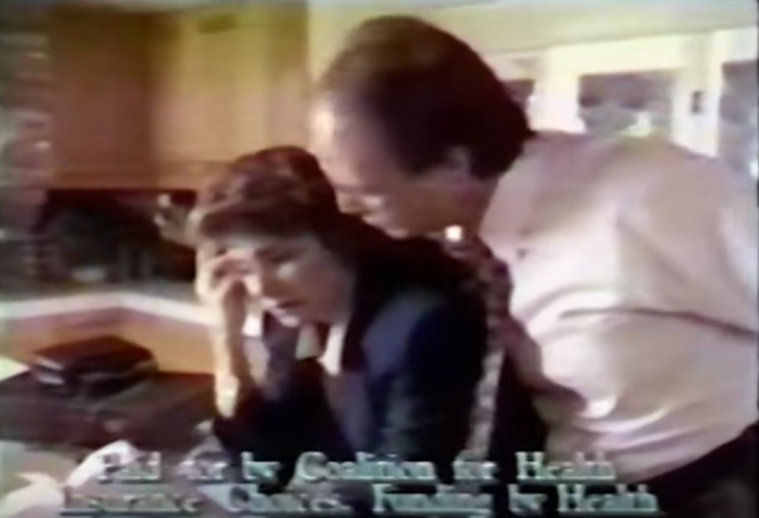Issue Ads a “Powerful Weapon” in the Lobbyist Arsenal

Issue advocacy in ads is a form of lobbying that indirectly attempts to influence decision-making by elected officials. So, what exactly is issue advocacy, or as some would say, issue advertising?
Perhaps the most famous- and effective- example occurred in 1993.
Remembered as the Harry and Louise ads, the television spot portrayed a middle-class couple discussing President Clinton’s plan for comprehensive healthcare.
A decidedly negative narrator states “the government may force us to pick from a few healthcare plans designed by government bureaucrats” to which Harry responds, “If they choose, we lose.”
The ad is often credited with helping to defeat the president’s healthcare plan in 1993.
Harry and Louise reappeared in 2009, only this time in support of the Patient Protection and Affordable Care Act, otherwise known as Obamacare.
Sitting at the kitchen table, Harry points to an article in a newspaper which notes “healthcare costs are up again. Small companies are being forced to cut their plans” causing Louise to maintain that the next president needs to “make something happen.”
The ad is thought to have helped build support for the passage of the Affordable Care Act.
Estimated to cost between $14 and $20 million, the 1993 advertisement was underwritten by the Health Insurance Association of America. Later, in 2009, the pharmaceutical industry trade group Families USA sponsored Harry and Louise’s multi-million ad buy.
Closer to home in New Jersey, the American Petroleum Institute and PSE&G recently did battle in dueling issue advocacy campaigns, this time including direct mail.
The contentious issue involved a $300 million proposed subsidy to PSE&G for the purpose of keeping three nuclear power plants open.
In one direct mail ad distributed in 2018, PSE&G prevails upon individual citizens to “contact your Trenton lawmakers to support a nuclear safety net,” maintaining that “for a low cost, carbon-free future, New Jersey needs nuclear.”
The opposing America Petroleum Institute ad exclaims “PSE&G Wants a Big Bailout.” It then goes on to implore citizens to “say no to the Big Bailout for PSE&G” by contacting their local legislator. The ad provides the name and phone number of the Senator or Assembly person in question.
The bill permitting the subsidies was enacted in May 2018 and the Board of Public Utilities (BPU) imposed it, though the Division of Rate Counsel has filed an appeal that remains pending.
The objective of issue advocacy is really no different than that of traditional lobbying. Traditional, or old school lobbying, employs paid professionals to contact elected officials directly in an attempt to influence public policy.
Issue advocacy lobbying attempts to do the same thing, only indirectly using a variety of tools, including T.V., radio, newspaper and social media advertising, all in an attempt to encourage viewers or recipients of ads to themselves contact elected officials about issues they care about.
In other words, million-dollar issue advocacy campaigns attempt to influence public policy by reinforcing the opinions of the citizenry and in turn inviting them to communicate their support or opposition to an issue to their representatives.
As noted in Interest Group Politics, edited by Allan J. Cigler and Burdett A Loomis, “issue advertising is a particular form of grassroots advocacy . . .Outside lobbying occurs when organized interests attempt to influence elected representatives indirectly by influencing the attitudes/or behavior of citizens whose subsequent votes the re-election minded representatives will seek.”
ELEC anticipated this trend in 1990, when White Paper 5- Lobbying Reform (written by this columnist) called for disclosure of expenditures for spending on grassroots lobbying.
“Through direct mail techniques, telemarketing, polling, and broadcast media, for instance, support or opposition to an issue can be mobilized as well as communicated to the public officials in question. Combined with a strong public relations effort, which includes building support among the press, these mass communications techniques could constitute a powerful weapon in the lobbyists campaign to mobilize and organize ‘grassroots’ support on behalf of the interests they represent.
Fourteen years later, a law was enacted in 2004 that required lobbyists to publicly detail this activity.
Genuine issue advocacy constitutes a campaign by special interests, usually wealthy and high-powered, to mobilize the public in support or opposition to issues under consideration by elected officials.
It is different than electioneering communication or election advocacy, though the line between the two types of advertising sometimes can be blurry.
Clever advertising people can produce ads prior to an election that discuss an issue in a negative or positive way and that ties a candidate to it in a way that is understood by any reasonable person as an ad in support or opposition to the candidate
Pure issue advocacy usually takes place between elections and not during them. It is a form of lobbying that is more sophisticated than traditional lobbying, utilizing mass media instead of direct contact by paid professional lobbyists to reach the same goal- influencing public policy.
This type of indirect lobbying is increasingly used by well-funded interest groups for a simple reason- it works.
Rallying the public behind an issue using this form of advocacy often can be a more effective strategy for influencing public policy than old school, “up close and personal” lobbying.
Jeff Brindle is the Executive Director of the New Jersey Election Law Enforcement Commission. The opinions presented here are his own and not necessarily those of the Commission.





